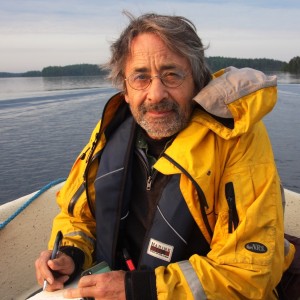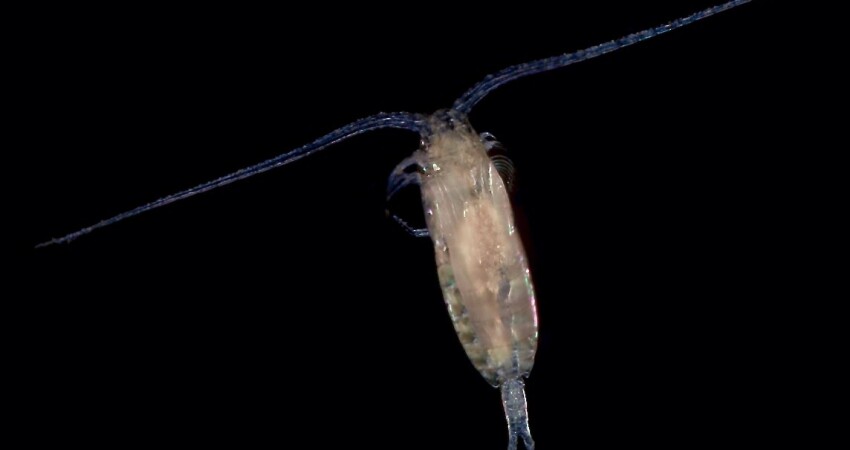For decades, researchers around the world have been observing negative trends in plankton population dynamics.
Jerry Leeman, executive director of the New England Fishermen's Stewardship Association (NEFSA), has become a prominent voice for New England fishermen. His passion for defending a way of life comes from having lived it. He knows his fish, but lately, he has focused on an invisible but essential component of the commercial fishing industry: plankton. Like many fishermen, Leeman opposes offshore wind farms, not only because of the space they take up and the dangers they create but because they kill plankton, the foundation of the marine food chain.
“The cooling systems for these windmills pump 8.1 million gallons of seawater through every day, heating it to 86 to 90 degrees and killing 100 percent of the plankton,” says Leeman, citing projections for Ørsted's 924-megawatt Sunrise Wind project off New York. “We’re seeing a 65 percent decline in the phytoplankton population in the Gulf of Maine over the last two decades, and we’re talking about putting wind farms that kill plankton in areas where we have no baseline for primary production.”
As Leeman notes, phytoplankton is the foundation of the marine food chain. It also provides upwards of 50 percent of the earth’s oxygen. Climate change, wind farms, agricultural run-off, microplastic, and a host of other threats are affecting plankton and it’s surprising that the decline of this vital component of the earth’s ecosystems is not front-page news.
“I’ve been shouting this from the rooftops for years now,” says Kieran Kelly, owner of the ocean plastics recovery company Ocean Integrity. “I can’t get anyone to listen. Globally, we’ve lost over 50 percent of the phytoplankton biomass since the 1950s, and we’re continuing to lose it about 1 to 2 percent a year. Never mind nuclear war. This is what’s going to kill us.”
Kelly notes the decline in size at the age of many fish stocks around the world and attributes it to the decline of phytoplankton and zooplankton. “It’s called stunting,” says Kelly. “And it means all our stock assessments are meaningless. They estimate a fish’s age by its size and the thing is that now, as fish mature at smaller sizes, what they’re calling a two-year-old cod may actually be a four-year-old cod.”
Numerous scientific studies confirm Kelly’s assertions. According to one paper recently published by Diana Fontaine and several University of Rhode Island and Woods Hole Oceanographic Institute researchers: “The NES [Northeast Continental Shelf], like other continental shelf systems, accounts for a disproportionate amount of primary production compared to its surface area (Muller-Karger et al. 2005). A reduction in summer NPP [net primary production] is likely to impact multiple components of the NES food web. Such a decline could propagate up the food web, resulting in reduced trophic transfer to commercially important fish or shifts in the degree of benthic-pelagic coupling that benthic organisms rely on.
For example, summer pelagic primary production is an essential energy source for demersal finfish on the US mid-Atlantic coast (Woodland and Secor 2013) and for benthic metabolism in nearby Southern New England waters (Fields et al. 2014). Thus, a reduction of NPP is expected to negatively affect these higher trophic levels.”
Another recent paper notes that lobster recruitment may depend more on the availability of the zooplankton Calanus finmarchicus for hungry lobster larvae to feed on than the level of spawner abundance.
In other words, in the absence of enough plankton at the right time, the floating larvae of fish, lobsters, and other commercially important species may be starving.
“The Fontaine paper just came out, and it is concerning,” says Harvey Walsh, Research Fishery Biologist at the Northeast Fisheries Science Center lab in Narragansett, Rhode Island. “We’re not seeing a decline in the large zooplankton like Calanus yet,” Walsh says. “But we are seeing an increase in smaller zooplankton.”
The problem for researchers, Walsh notes, is that plankton population dynamics can vary over space and time. “If we sample one place and then sample there three hours later, we may get different results. And there is a lot of interannual variability.” Walsh also notes that the physical and oceanographic drivers of planktonic population dynamics are changing so fast on the Northeast Continental Shelf that it is getting hard for scientists to track what is happening and why. “It’s harder to forecast where things are going,” he says. “We have to monitor more closely, especially if we’re going to be doing things that affect these ecosystems.”
Like Walsh, scientists all over the world have been tracking plankton for decades. In 2017, the Skippers Education Program, run by the Maine Center for Coastal Fisheries, sent student Betsey Brown to represent the program at the Slow Fish conference in Genoa, Italy. There, Brown had the opportunity to listen to Pierre Mollo, a renowned French expert on plankton. Mollo warned that overfishing was not the main cause of resource decline. He explained in a translated interview that marine plankton is dying due to pollution, global warming, and other causes.
“Marine biologists today note, almost everywhere, a decline in plankton biodiversity,” Mollo says in another interview. “When this diversity decreases, that of the zooplankton which feeds on it decreases as well, and therefore that of the larvae and fry, and so on, up to our plate. In short, the resource is depleted.”
Mollo describes a disturbing shift in phytoplankton population dynamics from abundant diatoms to less desirable dinoflagellates. “The sudden proliferation of this species is far from insignificant,” says Mollo. “50 years ago, when I was working in Houat, France, discovering a single dinoflagellate under a microscope was like a surprise. I would call to my friends: ‘Look, come see, I’ve got something good!’ At the time, diatoms dominated the flora. Today, when I return to Houat, I see dinoflagellates all the time and always in greater numbers.”
Mollo notes that among the 2400 species of dinoflagellates, some feed on phytoplankton species. “This is the case with the bioluminescent species, Noctiluca scintillans,” he says. “It is an armed predator. Dinoflagellate literally means ‘terrible whip.’ With this weapon, the species captures prey that is attracted to its bioluminescence, which is what we can consider to be a type of light fishing. Its favorite prey are the fine, crisp diatoms that zooplankton love. A sea that glows at night is a bad sign for fishermen,” Mollow says. “Because it means that micro-crustaceans and copepods are being devoured, leaving nothing for larvae and fry to eat. These hungry species cannot eat Noctiluca in turn, as it is too big for their microscopic mouths. As a result, fishermen must look elsewhere if they wish to bring home a decent catch.”
Microplastics are yet another aspect of the assault on what Mollo calls the irreplaceable foundation in the food chain, starting from photosynthesis all the way to our plates.
“Today, we can observe plastic microfilaments among the copepods or diatoms that are even present inside the plankton itself,” he says. “Most are identified as micro-fibers from synthetic textiles, notably "fleeces" created by the plastic recycling industry. These fibers enter the ocean by the billions each time these types of garments are washed.”
Zooplankton has been observed grazing on microplastic, and diatoms often attach to minute fibers and these work their way up the food chain. “We can now find these particles in salt from the ocean and in our excrements,” says Mollo. “There are traces of the chemical compounds that are contained in plastics which then pass into animals, like nano-residues from heavy metals or phthalates used to soften plastics. They are serious endocrine disruptors that can affect reproductive capacity, including also in humans.”
Kelly at Ocean Integrity agrees and calls for an end to plastic bottles and food containers. “They should be outlawed,” he says. Kelly cites the wearing down of automobile tires as a major contributor to ocean microplastics, and he raises an issue not often in the news but supported by science. “People don’t want to talk about it, but these chemicals are feminizing our boys,” he says, noting that the endocrine disruptors Mollo mentions, particularly phthalates used to soften plastic, mimic estrogen, leading to earlier puberty in girls and more feminine traits in boys.
“We must raise awareness and continue to constantly explain the roles, services, and multiple risks to plankton,” Mollo says. As he explained to Betsey Brown, Mollo believes that fisheries decline is, in part, a factor of plankton decline. “Personally, I’ve been paddling against the tide for 30 years,” he said. “Waiting for someone to listen to what I’m telling you today.”







